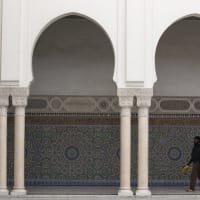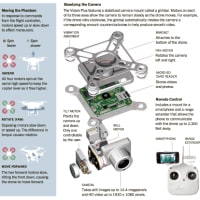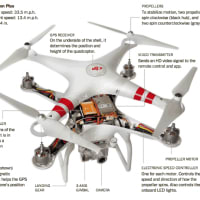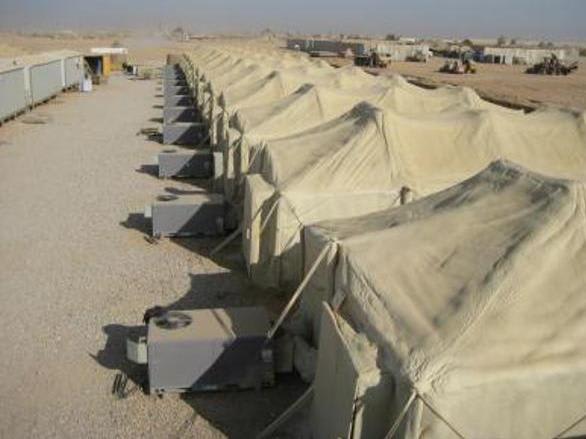
Among The Costs Of War: $20B In Air Conditioning
戦費:エアコンだけで200億ドル
by NPR Staff
June 25, 2011
Courtesy Steven Anderson
Air conditioners keep tents cool on a U.S. military base in Iraq. The tents have been treated with polyurethane foam to increase energy efficiency.
スティーブン・アンダーソン提供
イラクの軍事基地のテントを冷やす空調器。 テントはエネルギー効率を上げるために、ポリウレタン加工を施してある。
text size A A A
June 25, 2011
The amount the U.S. military spends annually on air conditioning in Iraq and Afghanistan: $20.2 billion.
軍はイラクとアフガニスタンでの施設の空調に年間202億ドルを費やしている。
That's more than NASA's budget. It's more than BP has paid so far for damage during the Gulf oil spill. It's what the G-8 has pledged to help foster new democracies in Egypt and Tunisia.
これはNASAの予算よりも大きく、メキシコ湾でのオイル流出による損害にこれまで支払われたBPの賠償金よりも大きい。 その額はエジプトはチュニジアの民主化を支援するため、G8が約束した支援額に相当する。
"When you consider the cost to deliver the fuel to some of the most isolated places in the world — escorting, command and control, medevac support — when you throw all that infrastructure in, we're talking over $20 billion," Steven Anderson tells weekends on All Things Considered guest host Rachel Martin. Anderson is a retired brigadier general who served as Gen. David Patreaus' chief logistician in Iraq.
“世界で最も孤立したような地域に燃料を配布するコストを考えるとき、―― 輸送警護、指揮統制、救護後送支援 ―― などこれらのインフラを放することを考えるとき、我々は200億ドルを超える規模の話をしている。”とスティーブ・アンダーソンは週末に、オールシングスコンシダードのゲストホストであるラチェル・マーティンに語った。
アンダースンはデイビッド・パトロース将軍にイラクで兵站専門家チーフとして仕えた元准将である。
Why does it cost so much? なぜそんなに費用がかかるのか?
To power an air conditioner at a remote outpost in land-locked Afghanistan, a gallon of fuel has to be shipped into Karachi, Pakistan, then driven 800 miles over 18 days to Afghanistan on roads that are sometimes little more than "improved goat trails," Anderson says. "And you've got risks that are associated with moving the fuel almost every mile of the way."
陸上奥地のアフガニスタンの孤絶した前哨基地のエアコンを稼働させるために、1ガロンの燃料はパキスタンのカラチに送られ、そこから18日かけて、時には、アンダースンに言わせると“ヤギの道に毛の生えたような道路”を800マイルもドライブする。
“そして、途上の1マイルごとの移動に危険をともなう。”
Anderson calculates more than 1,000 troops have died in fuel convoys, which remain prime targets for attack. Free-standing tents equipped with air conditioners in 125 degree heat require a lot of fuel. Anderson says by making those structures more efficient, the military could save lives and dollars.
アンダースンによると、これまで燃料輸送隊での戦死者は1000人を超えるという。そして輸送隊は今でも敵の主目標である。 50℃以上の熱波の下で、エアコンつきの支柱無しテントは大量の燃料を必要とする。 アンダースンは、この構造を効率的にすることで軍は兵士の命を守ると同時に経費も抑えていると言う。
Still, his $20.2 billion figure raises stark questions about the ongoing war in Afghanistan. In the wake of President Obama's announcement this week that about 30,000 American troops will soon return home, how much money does the U.S. stand to save?
彼の202億ドルという数字は、アフガニスタンで継続中の戦争について、なお厳しい問いかけをする。 3万人もの米軍が近いうちに撤退するという、オバマ大統領の今週の発表の結果、いったいいくらの撤退費用を準備しているのだろうか?
Dollars And Cents
The 30,000 troops who will return home by the end of next year were sent to Afghanistan in 2009, at a cost of about $30 billion. That comes out to about $1 million a soldier.
来年の末までに撤退するという3万人の軍隊は、2009年に約300億ドルをかけてアフガニスタンに投入された部隊であり、一人当たりにすると100万ドルに相当する。
But the savings of withdrawing those troops won't equal out, experts say.
しかし、部隊の撤収による経費削減は戦力投入時とは同じではないと専門家は言う。
"What history has told us is that you don't see a proportional decrease in spending based on the number of troops when you draw them down," Chris Hellman, a senior research analyst at the National Priorities Project, tells Martin.
“歴史が我々に教えてくれていることは、撤収するときは軍費が部隊の大きさに比例して小さくはならないということである。”とナショナルプライオリティーズプロジェクトのシニアリサーチアナリストのクリス・ヘルマンはマーティンに話している。
"In Afghanistan that's going to be particularly true because it's a very difficult and austere environment in which to operate," he says.
“アフガニスタンでは特にそのことが顕著に表れるだろう、なぜなら過酷な環境下での撤収作戦は非常に困難だからだ。”と彼は言う。
That means most war expenditures lie not in the troops themselves but in the infrastructure that supports them — infrastructure that in some cases will remain in place long after troops are gone.
というのは戦費は部隊そのものよりも、部隊を支援するインフラにかかっていることを意味している。――そして、そのインフラはあるケースでは部隊が去った後も、その場に長期残置される。
"We're building big bases," American University professor Gordon Adams tells Martin. The costs of those bases are, in economic terms, "sunk" costs, he says.
“我々は建設している基地はとても大きい。”“これらの基地にかかるコストのことを経済学の用語では「サンク(沈んだ)」コストと称します。”とアメリカの大学教授のゴードン・アダムスはマーティンに説明した。
"We're seeing this in Iraq. We're turning over to the Iraqis — mostly either for a small penny or for free — the infrastructure that we built in Iraq. But we won't see back any money from that infrastructure."
“イラクに、この例をみてとれます。 我々はイラクに引き継ごうとしています。―― ほとんどただ同然で―― インフラは我々がイラクに建設したが、そのインフラから我々は何も経済的な戻りは期待できない。
Then there's the costly task of training Afghan security forces. The Obama administration has requested almost $13 billion to train and equip Afghan security forces in the next fiscal year.
それに、アフガニスタンの治安維持軍の訓練という金のかかる任務もある。 オバマ政権は約130億ドルの予算を、この訓練と治安維持軍の装備の予算として来年度予算要求をしている。
And more importantly, Hellman says, "[Afghan President Hamid] Karzai indicated a couple years back that [Afghanistan] wasn't going to be a position to support their own military forces 15, 20 years out. I suspect we're going to be called on to pay a substantial part of that bill going forward."
そして、さらに重要なのはアフガニスタンのカルザイ大統領が2年前に戻って、アフガニスタンは自国の軍隊を15年~20年支えきることはできないと言っていることだ。我々は将来に先行するこれらの費用の大半を支払うことを要求されるのではないかと懸念している、とヘルマンは言った。
Criticism From The President's Own Party
For critics of the president, the idea that the troop drawdown won't save much money is reason enough to suggest it should be bigger.
One outspoken critic is Sen. Joe Manchin (D-WV). He notes the wars in Afghanistan and Iraq have cost hundreds of billions of dollars so far, and he argues a larger troop drawdown isn't a national security risk.
大統領の批評家たちにとって、軍の縮小は対して経費の削減にならないという考えは、だから軍の撤退規模を大きくすべきだということにはならない。
辛辣な批判者であるマンチン上院議員はアフガニスタンとイラクにおける戦争は数千億ドルの軍費をこれまで投入しているとし、大規模な撤退は米国の安全を脅かさないと主張する。
"We have the greatest special ops in the world. We have more technology than any other country on earth," Manchin tells Martin. "Do we actually need to have 70,000 troops on the ground?"
“我々は世界でもっとも壮大な特殊作戦を遂行した。我々は世界のどの国よりも高い軍事技術を誇っている。実際、そのアメリカが7万もの軍隊を、かの地に展開しておく必要があるのか?”とマンチンはマーティンの話した。
"When you have this many people in a country that doesn't want you there — that has no economy, no infrastructure and a corrupt government — and you're trying to stabilize it and build them into a viable nation? I'm not sure we have enough time, and I definitely know we don't have enough money," Manchin says.
続けて、彼は“いてほしくないという国に多くの兵士を展開している。―― その国ときたら経済は機能してないし、インフラは無い、おまけに政府は腐敗している。―― それなのに政府はその国を安定化し、自立可能な国家に建設しようとしている。 私はそんな暇があるとは思えない。少なくとも絶対にそんなことをする十分な金がわが国には絶対にない。”と話した。
But others argue war should be waged independent of cost.
"The realm of war and peace exists separately apart — and justifiably so — from the economic realm," says Lawrence Kaplan, a visiting professor at the U.S. Army War College, who says critics like Manchin are looking for "economic answers to a non-economic question.
しかし、戦争は独立したコストで遂行されるべきだという者もいる。
“戦争と平和の世界は別々に存在する。――― またそうあって当然だ ――― 経済的分野の観点から”と米国陸軍大学(アーミーウォーカレッヂ)の客員教授のローレンス・カプランは語る。彼に言わせるとマンチンのような批判者は非経済分野に経済の回答を求めようとしているとのこと。
"And anyway, it's not the war that's broken Washington's piggy bank," he adds, noting that Medicare, Medicaid and Social Security account for far more spending than the $107 billion the Pentagon says it will spend in Afghanistan next year.
“そして、それは何も政府のなけなしの金を戦争が使い果たしているという話ではない”と、メディケアやメディケイドのような医療制度が、アフガニスタンの戦費予算を凌駕することを引き合いにだしながら、彼は付け加えた。
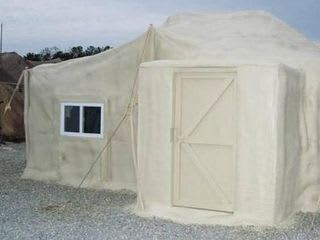
Courtesy Steven Anderson
A U.S. military tent after treatment with polyurethane foam. A 2006 test of the foam cut energy use by 92 percent, says retired Brig. Gen. Steven Anderson.
スティーブン・アンダーソン提供
ポリウレタンフォームの処理がなされた米軍のテント。2006年の試験で電力使用を92パーセント従来から削減したとスティーブ・アンダーソン准将の説明。
"Remember, we're talking about 30,000 troops," he says "I don't think that hundred-billion-dollar price tag should be the determining one."
“我々は約3万人の軍隊について話しているのであり、数千億ドルの金の問題は、まず論ずべき決定的な問題ではない。”とカプランは言う。
Can Greener Mean Safer?
But for Anderson, the retired brigadier general, economics does have a role to play in modern warfare.
しかし、アンダーソン元准将とっては、経済は現代戦において演ずべき役割を担っている。
Anderson advocates for increased energy efficiency for military structures in order to cut down on the need for long, dangerous fuel-transport missions.
アンダーソンは長距離の危険な燃料輸送任務の損耗を抑えるためにも軍事組織の更なるエネルギー効率を主張している。
A few months ago, Anderson heard from a company commander in Afghanistan."He literally has to stop his combat operations for two days every two weeks so he can go back and get his fuel. And when he's gone, the enemy knows he's gone, and they go right back to where they were before. He has to start his counter-insurgency operations right back at square one."
数か月前、アフガニスタンのある中隊長から次のような話を聞いた。“彼は文字通り燃料を調達に戻るために2週間に2日は作戦を中止しなければならなかった。 彼の部隊が戦線を離脱すると、敵は察知して、掃討される前の前線まで戻ってくる。 そこで、彼の部隊は対ゲリラ掃討作戦を振り出しに戻って開始することになると。”
Anderson says experiments with polyurethane foam insulation for tents in Iraq cut energy use by 92 percent and took 11,000 fuel trucks off the road. But he adds there's a lack of enthusiasm for a greener military among top commanders.
"People look at it and say 'It's not my lane. We don't need to tie the operational commanders' hands' — things like this," he says.
"A simple policy signed by the secretary of defense — a one- or two-page memo, saying we will no longer build anything other than energy-efficient structures in Iraq and Afghanistan — would have a profound impact."
アンダースンはテントのポリウレタンフォーム断熱試験はイラクにおいてエネルギーコストの92%を削減し、11000両のトラックの運行を削減できたと言う。しかしトップの指揮官連中で経験の少ない者のなかには、あまり、そのような経済効率に関心がない者がいる。 “そんな努力をみても、それは自分の正面のことではない。 作戦に従事する指揮官同士が横並びに手を携えてする必要はない。”と言うような奴らだ。
“国防長官によって署名されたシンプルな方針 ――― 1~2枚のメモでいい、我々はイラク及びアフガニスタンにおいてエネルギー効率の悪い施設は金輪際建設しないという一文を入れれば、それは非常にインパクトは図りしれない。”
戦費:エアコンだけで200億ドル
by NPR Staff
June 25, 2011
Courtesy Steven Anderson
Air conditioners keep tents cool on a U.S. military base in Iraq. The tents have been treated with polyurethane foam to increase energy efficiency.
スティーブン・アンダーソン提供
イラクの軍事基地のテントを冷やす空調器。 テントはエネルギー効率を上げるために、ポリウレタン加工を施してある。
text size A A A
June 25, 2011
The amount the U.S. military spends annually on air conditioning in Iraq and Afghanistan: $20.2 billion.
軍はイラクとアフガニスタンでの施設の空調に年間202億ドルを費やしている。
That's more than NASA's budget. It's more than BP has paid so far for damage during the Gulf oil spill. It's what the G-8 has pledged to help foster new democracies in Egypt and Tunisia.
これはNASAの予算よりも大きく、メキシコ湾でのオイル流出による損害にこれまで支払われたBPの賠償金よりも大きい。 その額はエジプトはチュニジアの民主化を支援するため、G8が約束した支援額に相当する。
"When you consider the cost to deliver the fuel to some of the most isolated places in the world — escorting, command and control, medevac support — when you throw all that infrastructure in, we're talking over $20 billion," Steven Anderson tells weekends on All Things Considered guest host Rachel Martin. Anderson is a retired brigadier general who served as Gen. David Patreaus' chief logistician in Iraq.
“世界で最も孤立したような地域に燃料を配布するコストを考えるとき、―― 輸送警護、指揮統制、救護後送支援 ―― などこれらのインフラを放することを考えるとき、我々は200億ドルを超える規模の話をしている。”とスティーブ・アンダーソンは週末に、オールシングスコンシダードのゲストホストであるラチェル・マーティンに語った。
アンダースンはデイビッド・パトロース将軍にイラクで兵站専門家チーフとして仕えた元准将である。
Why does it cost so much? なぜそんなに費用がかかるのか?
To power an air conditioner at a remote outpost in land-locked Afghanistan, a gallon of fuel has to be shipped into Karachi, Pakistan, then driven 800 miles over 18 days to Afghanistan on roads that are sometimes little more than "improved goat trails," Anderson says. "And you've got risks that are associated with moving the fuel almost every mile of the way."
陸上奥地のアフガニスタンの孤絶した前哨基地のエアコンを稼働させるために、1ガロンの燃料はパキスタンのカラチに送られ、そこから18日かけて、時には、アンダースンに言わせると“ヤギの道に毛の生えたような道路”を800マイルもドライブする。
“そして、途上の1マイルごとの移動に危険をともなう。”
Anderson calculates more than 1,000 troops have died in fuel convoys, which remain prime targets for attack. Free-standing tents equipped with air conditioners in 125 degree heat require a lot of fuel. Anderson says by making those structures more efficient, the military could save lives and dollars.
アンダースンによると、これまで燃料輸送隊での戦死者は1000人を超えるという。そして輸送隊は今でも敵の主目標である。 50℃以上の熱波の下で、エアコンつきの支柱無しテントは大量の燃料を必要とする。 アンダースンは、この構造を効率的にすることで軍は兵士の命を守ると同時に経費も抑えていると言う。
Still, his $20.2 billion figure raises stark questions about the ongoing war in Afghanistan. In the wake of President Obama's announcement this week that about 30,000 American troops will soon return home, how much money does the U.S. stand to save?
彼の202億ドルという数字は、アフガニスタンで継続中の戦争について、なお厳しい問いかけをする。 3万人もの米軍が近いうちに撤退するという、オバマ大統領の今週の発表の結果、いったいいくらの撤退費用を準備しているのだろうか?
Dollars And Cents
The 30,000 troops who will return home by the end of next year were sent to Afghanistan in 2009, at a cost of about $30 billion. That comes out to about $1 million a soldier.
来年の末までに撤退するという3万人の軍隊は、2009年に約300億ドルをかけてアフガニスタンに投入された部隊であり、一人当たりにすると100万ドルに相当する。
But the savings of withdrawing those troops won't equal out, experts say.
しかし、部隊の撤収による経費削減は戦力投入時とは同じではないと専門家は言う。
"What history has told us is that you don't see a proportional decrease in spending based on the number of troops when you draw them down," Chris Hellman, a senior research analyst at the National Priorities Project, tells Martin.
“歴史が我々に教えてくれていることは、撤収するときは軍費が部隊の大きさに比例して小さくはならないということである。”とナショナルプライオリティーズプロジェクトのシニアリサーチアナリストのクリス・ヘルマンはマーティンに話している。
"In Afghanistan that's going to be particularly true because it's a very difficult and austere environment in which to operate," he says.
“アフガニスタンでは特にそのことが顕著に表れるだろう、なぜなら過酷な環境下での撤収作戦は非常に困難だからだ。”と彼は言う。
That means most war expenditures lie not in the troops themselves but in the infrastructure that supports them — infrastructure that in some cases will remain in place long after troops are gone.
というのは戦費は部隊そのものよりも、部隊を支援するインフラにかかっていることを意味している。――そして、そのインフラはあるケースでは部隊が去った後も、その場に長期残置される。
"We're building big bases," American University professor Gordon Adams tells Martin. The costs of those bases are, in economic terms, "sunk" costs, he says.
“我々は建設している基地はとても大きい。”“これらの基地にかかるコストのことを経済学の用語では「サンク(沈んだ)」コストと称します。”とアメリカの大学教授のゴードン・アダムスはマーティンに説明した。
"We're seeing this in Iraq. We're turning over to the Iraqis — mostly either for a small penny or for free — the infrastructure that we built in Iraq. But we won't see back any money from that infrastructure."
“イラクに、この例をみてとれます。 我々はイラクに引き継ごうとしています。―― ほとんどただ同然で―― インフラは我々がイラクに建設したが、そのインフラから我々は何も経済的な戻りは期待できない。
Then there's the costly task of training Afghan security forces. The Obama administration has requested almost $13 billion to train and equip Afghan security forces in the next fiscal year.
それに、アフガニスタンの治安維持軍の訓練という金のかかる任務もある。 オバマ政権は約130億ドルの予算を、この訓練と治安維持軍の装備の予算として来年度予算要求をしている。
And more importantly, Hellman says, "[Afghan President Hamid] Karzai indicated a couple years back that [Afghanistan] wasn't going to be a position to support their own military forces 15, 20 years out. I suspect we're going to be called on to pay a substantial part of that bill going forward."
そして、さらに重要なのはアフガニスタンのカルザイ大統領が2年前に戻って、アフガニスタンは自国の軍隊を15年~20年支えきることはできないと言っていることだ。我々は将来に先行するこれらの費用の大半を支払うことを要求されるのではないかと懸念している、とヘルマンは言った。
Criticism From The President's Own Party
For critics of the president, the idea that the troop drawdown won't save much money is reason enough to suggest it should be bigger.
One outspoken critic is Sen. Joe Manchin (D-WV). He notes the wars in Afghanistan and Iraq have cost hundreds of billions of dollars so far, and he argues a larger troop drawdown isn't a national security risk.
大統領の批評家たちにとって、軍の縮小は対して経費の削減にならないという考えは、だから軍の撤退規模を大きくすべきだということにはならない。
辛辣な批判者であるマンチン上院議員はアフガニスタンとイラクにおける戦争は数千億ドルの軍費をこれまで投入しているとし、大規模な撤退は米国の安全を脅かさないと主張する。
"We have the greatest special ops in the world. We have more technology than any other country on earth," Manchin tells Martin. "Do we actually need to have 70,000 troops on the ground?"
“我々は世界でもっとも壮大な特殊作戦を遂行した。我々は世界のどの国よりも高い軍事技術を誇っている。実際、そのアメリカが7万もの軍隊を、かの地に展開しておく必要があるのか?”とマンチンはマーティンの話した。
"When you have this many people in a country that doesn't want you there — that has no economy, no infrastructure and a corrupt government — and you're trying to stabilize it and build them into a viable nation? I'm not sure we have enough time, and I definitely know we don't have enough money," Manchin says.
続けて、彼は“いてほしくないという国に多くの兵士を展開している。―― その国ときたら経済は機能してないし、インフラは無い、おまけに政府は腐敗している。―― それなのに政府はその国を安定化し、自立可能な国家に建設しようとしている。 私はそんな暇があるとは思えない。少なくとも絶対にそんなことをする十分な金がわが国には絶対にない。”と話した。
But others argue war should be waged independent of cost.
"The realm of war and peace exists separately apart — and justifiably so — from the economic realm," says Lawrence Kaplan, a visiting professor at the U.S. Army War College, who says critics like Manchin are looking for "economic answers to a non-economic question.
しかし、戦争は独立したコストで遂行されるべきだという者もいる。
“戦争と平和の世界は別々に存在する。――― またそうあって当然だ ――― 経済的分野の観点から”と米国陸軍大学(アーミーウォーカレッヂ)の客員教授のローレンス・カプランは語る。彼に言わせるとマンチンのような批判者は非経済分野に経済の回答を求めようとしているとのこと。
"And anyway, it's not the war that's broken Washington's piggy bank," he adds, noting that Medicare, Medicaid and Social Security account for far more spending than the $107 billion the Pentagon says it will spend in Afghanistan next year.
“そして、それは何も政府のなけなしの金を戦争が使い果たしているという話ではない”と、メディケアやメディケイドのような医療制度が、アフガニスタンの戦費予算を凌駕することを引き合いにだしながら、彼は付け加えた。

Courtesy Steven Anderson
A U.S. military tent after treatment with polyurethane foam. A 2006 test of the foam cut energy use by 92 percent, says retired Brig. Gen. Steven Anderson.
スティーブン・アンダーソン提供
ポリウレタンフォームの処理がなされた米軍のテント。2006年の試験で電力使用を92パーセント従来から削減したとスティーブ・アンダーソン准将の説明。
"Remember, we're talking about 30,000 troops," he says "I don't think that hundred-billion-dollar price tag should be the determining one."
“我々は約3万人の軍隊について話しているのであり、数千億ドルの金の問題は、まず論ずべき決定的な問題ではない。”とカプランは言う。
Can Greener Mean Safer?
But for Anderson, the retired brigadier general, economics does have a role to play in modern warfare.
しかし、アンダーソン元准将とっては、経済は現代戦において演ずべき役割を担っている。
Anderson advocates for increased energy efficiency for military structures in order to cut down on the need for long, dangerous fuel-transport missions.
アンダーソンは長距離の危険な燃料輸送任務の損耗を抑えるためにも軍事組織の更なるエネルギー効率を主張している。
A few months ago, Anderson heard from a company commander in Afghanistan."He literally has to stop his combat operations for two days every two weeks so he can go back and get his fuel. And when he's gone, the enemy knows he's gone, and they go right back to where they were before. He has to start his counter-insurgency operations right back at square one."
数か月前、アフガニスタンのある中隊長から次のような話を聞いた。“彼は文字通り燃料を調達に戻るために2週間に2日は作戦を中止しなければならなかった。 彼の部隊が戦線を離脱すると、敵は察知して、掃討される前の前線まで戻ってくる。 そこで、彼の部隊は対ゲリラ掃討作戦を振り出しに戻って開始することになると。”
Anderson says experiments with polyurethane foam insulation for tents in Iraq cut energy use by 92 percent and took 11,000 fuel trucks off the road. But he adds there's a lack of enthusiasm for a greener military among top commanders.
"People look at it and say 'It's not my lane. We don't need to tie the operational commanders' hands' — things like this," he says.
"A simple policy signed by the secretary of defense — a one- or two-page memo, saying we will no longer build anything other than energy-efficient structures in Iraq and Afghanistan — would have a profound impact."
アンダースンはテントのポリウレタンフォーム断熱試験はイラクにおいてエネルギーコストの92%を削減し、11000両のトラックの運行を削減できたと言う。しかしトップの指揮官連中で経験の少ない者のなかには、あまり、そのような経済効率に関心がない者がいる。 “そんな努力をみても、それは自分の正面のことではない。 作戦に従事する指揮官同士が横並びに手を携えてする必要はない。”と言うような奴らだ。
“国防長官によって署名されたシンプルな方針 ――― 1~2枚のメモでいい、我々はイラク及びアフガニスタンにおいてエネルギー効率の悪い施設は金輪際建設しないという一文を入れれば、それは非常にインパクトは図りしれない。”















